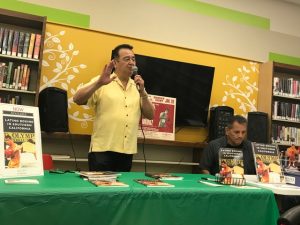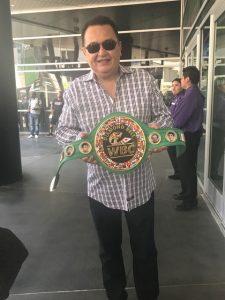“It took over two years to write my first book, but it took a LIFETIME to collect it.” – Award-winning boxing historian GENE AGUILERA
Author Gene Aguilera is back with a brand new book! After his best-selling “Mexican American Boxing in Los Angeles,” the noted boxing historian delivers a powerful follow-up with his “Latino Boxing in Southern California” (Arcadia Publishing).
I’ve known Gene for several years now; he’s one of the most well-liked people in boxing circles, Always amiable, professional and positive, the premiere boxing aficionado has been involved in the sport for many decades. He has visited countless gyms, put in endless hours writing about the sweet science and takes time to build long-lasting friendships with fighters, trainers, cornermen and more.
Boxing in Southern California has delivered a rich history through the golden ages of pugilism. Dotting the boxing landscape were so many prizefighters that (for whatever reasons) never got their fair share of the limelight. Gene is a bright light in this world of punchers and provides the details and respect that these blood-and-guts sluggers deserve. Not only does he understand and respect the sport, he can take you back in time with his amazing memories, colorful anecdotes and bittersweet memories of a bygone era.
 His first book was an instant classic and I enjoyed checking out his brand new sequel as well. “Latino Boxing in Southern California” features full color photos that pop from the pages and transports you back in time! It’s a beautiful tome honoring–and preserving–history for both the casual boxing fan to the diehard fan to everyone in between. He lets the athletes shine as we see them jump up from the pages.
His first book was an instant classic and I enjoyed checking out his brand new sequel as well. “Latino Boxing in Southern California” features full color photos that pop from the pages and transports you back in time! It’s a beautiful tome honoring–and preserving–history for both the casual boxing fan to the diehard fan to everyone in between. He lets the athletes shine as we see them jump up from the pages.But these gladiators were also mere mortals. While they had their hands raised in victory, there was always the other side of fight game too. Gene does a great job of covering all ground in his new title. A large portion of these champions are no longer with us but their hard-fought legacies live on in both “Latino Boxing in Southern California” and “Mexican American Boxing in Los Angeles.”
The banker-by-day and boxing historian in his spare time has been honored with many awards and accolades through the years. Gene is known for his Gung-ho attitude, nose to the grindstone work ethic, and upbeat personality. He’s also a loyal family man with his beautiful wife, Maria, and darling daughters, Emily and Melanie (whom I’ve watched grow up).
On October 20, Gene will be receiving his newest Hall of Fame award from Don Fraser and Bill and Linda Young as a 2018 Inductee in their organizations California Boxing Hall of Fame (presented by the National Boxing Hall of Fame).
In the next couple of months, the popular author has a very busy schedule planned with historic book signings, a huge library tour, radio shows and several personal appearance in and around SoCal. Gene has energy to spare and he never ceases to amaze anyone who knows him.
During a break in his schedule and world travels, I caught up with the prolific writer. In this comprehensive Q&A, hear what the L.A. author reveals about his book, boxing life and his famous buddies in the sport.
Hear firsthand what it was really like hangin’ out with the legends, learn how his passion for boxing was formed and listen to his stories behind the iconic photos showcased in Gene Aguilera’s new book!
Michele Chong: Hi Gene, congrats on your new book “Latino Boxing in Southern California”! This is a sequel to your first book “Mexican American Boxing in Los Angeles.” Talk about why it’s been your passion to continue telling this history?
Gene Aguilera: Thank you, Michele! It’s so great to talk to you again. After releasing my first book in 2014, I felt there was so much more to the story. There were the inevitable local boxers who were left out (such as Joey Orbillo–a local heavyweight from Wilmington, California) due to space constraints. But waiting inside of me was a whole other book to write, about Latino and Mexican ring idols who arrived from south of the border to wreak havoc on the West Coast.
 My first book centered on the Mexican American fighters who battled at the Olympic Auditorium (such as Bobby Chacon, Carlos Palomino, Danny “Little Red” Lopez, Herman Montes, Frankie Duarte, Alberto Davila, Joey Olivo, Armando Muniz, Mando Ramos, etc.). But this new book features some of the great Latino boxers from Mexico, Puerto Rico, Cuba, Panama, Nicaragua, etc. who found success in the Southern California area. In “Latino Boxing in Southern California,” you will find beautiful color photos/posters/magazine covers of Julio Cesar Chavez, Salvador Sanchez, Roberto Duran, Ruben Olivares, Carlos Zarate, Lupe Pintor, Alfonso Zamora, Pipino Cuevas, Ricardo “Finito” Lopez, Chiquita Gonzalez, Alexis Arguello, Jose “Mantequilla” Napoles, and so on. All of them great Latino/Mexican fighters who did not fit into the theme of my first book, “Mexican American Boxing in Los Angeles.”
My first book centered on the Mexican American fighters who battled at the Olympic Auditorium (such as Bobby Chacon, Carlos Palomino, Danny “Little Red” Lopez, Herman Montes, Frankie Duarte, Alberto Davila, Joey Olivo, Armando Muniz, Mando Ramos, etc.). But this new book features some of the great Latino boxers from Mexico, Puerto Rico, Cuba, Panama, Nicaragua, etc. who found success in the Southern California area. In “Latino Boxing in Southern California,” you will find beautiful color photos/posters/magazine covers of Julio Cesar Chavez, Salvador Sanchez, Roberto Duran, Ruben Olivares, Carlos Zarate, Lupe Pintor, Alfonso Zamora, Pipino Cuevas, Ricardo “Finito” Lopez, Chiquita Gonzalez, Alexis Arguello, Jose “Mantequilla” Napoles, and so on. All of them great Latino/Mexican fighters who did not fit into the theme of my first book, “Mexican American Boxing in Los Angeles.”Also in this new book, I transport the reader back to the axis of boxing in Southern California, which was the Olympic Auditorium and the Main St. Gym. Unfortunately these two institutions no longer exist today. The Olympic Auditorium is now a Korean Church and the Main St. Gym is now a parking lot. I remember crossing the bridge from East L.A. (where I used to live) to reach these beloved boxing shrines, where I began a string of lifelong friendships with many of the boxers I went to see train and box. One friendship in particular stands out: my bond with possibly the greatest bantamweight that ever lived, the four-time champion of the world and hall of famer, “Mr. Knockout” Ruben Olivares. Ruben and I have stayed close for over 40 years now, and I have accompanied him almost every year to the International Boxing Hall of Fame, in Canastota, New York, since his induction in 1991. (Note: the Hall began in 1990). Ruben even baptized my daughter Melanie six years ago, so now we are officially “compadres”!
MC: You’ve mentioned it took two years to write your first book. What, if anything, was better or worse or different in writing this current sequel when comparing it to your first book?
GA: Yes, it took over two years to write my first book, but it took a lifetime to collect it. It was the first boxing book to put together all the illustrious local Los Angeles-based Mexican American boxers in one place. Burning the midnight oil to write both my first book and this new book, was a labor of love, never a chore. While I deliriously typed away into many deep, dark, and lonely nights; my dreams became haunted by visions of boxers featured in my book. The pressure was on to get the story right. And ladies and gentlemen, I think we did.
Writing “Latino Boxing in Southern California” was a much more pleasant and easier experience than putting together my first book. In the first book, I was like a deer in headlights. It was my first book, but it felt like I wrote 10 books. In other words, I did way too much writing and left much of it on the cutting room floor. For my second book, I knew exactly what to do. Laying it out (or pre-planning it) was the key and everything flowed from there. First thing I did, was to choose all the pictures that were going to be in the book, then I put them in chronological order, safely protected in plastic sheet covers in three-ring binders. Essentially I was done, that was my pre-book.
For my second book, I wanted it to be much different than my first (which was in black and white). So I spoke to my editor, and convinced her to release this one in glorious, real-life, techicolor! As you will see, this book is a colorful tribute to the sweet science, Los Angeles-style. The pictures literally jump out of the book like bright lights. Most importantly, it keeps the memory alive of when boxing in this town revolved around the beloved Olympic Auditorium, Main St. Gym, and the Fabulous Forum.
MC: Are there any plans for a third book?
GA: Yes, Michele, I am kicking around some ideas for a third book. I’m sure my wife would not like to hear that, but I’m sure she will understand (again). Writing a book does take a lot of time away from the family. Thank God she has grown to love boxing, otherwise it would be a tough sell. She watches Saturday night boxing with me, attends some of the local bouts (at Staples, StubHub Center, etc), and enjoys attending our local hall of fame banquets to see our friends.
This upcoming third book would make the trilogy complete, in terms of Mexican American/Latino Boxing. I don’t want to give away the theme or title yet, but it’s marinating in my head as we speak. Since it takes about two years to write, I should start writing soon so it can come out at least in 2021!
Then, eventually, I would like to write a biography on someone like the original “Golden Boy” Art Aragon, Mando Ramos or “Rockabye” Ruben Olivares. By then, I should have a lot more time to tackle these different projects.
MC: You’ve had several book signings in local communities. Tell me what that’s been like and how the reaction has been from the boxing community?
GA: “Latino Boxing in Southern California” was just released on June 4, 2018, and so far the reaction to it has been very well-received. We’ve had book presentations/signings at South El Monte, Lynwood, Norwalk, and Compton Libraries. I want to thank Oscar “The Boxer” Muniz, Israel “Magnifico” Vazquez, and trainer Dub Huntley for being my guests at these signings.
Also, we recently did on-air interviews with Gustavo Vargas at El Aviso Radio and Quincy Shelton of The Talk 2 Q Radio Show and spoke at a Belvedere Vets meeting thanks to my friend Fred Hermosillo.
I want to thank the following people for their positive and encouraging reviews that have appeared on social media, so far: Rick Farris/West Coast Boxing Hall of Fame (I received their 2015 Boxing Book of the Year Award), David A. Avila/www.sweetscience.com, Jack Hirsch/boxingnewsonline.net, Steve DeBro/Olympic Auditorium Project, Allen Charmin’ Larman/KPFK Radio , Kevin H. Donan/As The Record Turns, Randy De La O/Thoughts on Boxing, Boxers and Fights, David Martinez/www.dmboxing.com, John J. Raspanti/ www.maxboxing.com, Joe Adame/Law Offices of Michael D. Luppi.Also, I want to thank the following people who have inducted me into their prospective boxing hall of fame organizations: Rudy Tellez/WBC Legends of Boxing Museum, Bill and Linda Dempsey Young/National Boxing Hall of Fame and Don Fraser/California Boxing Hall of Fame (upcoming October 20, 2018).
MC: Your photos and summaries in the book really take us back in time. What’s your memory about the picture of you in the ring with singer Little Willie G (Thee Midniters) at the Jorge Paez fight?
GA: I want to thank Jim FitzGerald of Forum Boxing for arranging to have Little Willie G. sing the National Anthem before the Jorge Paez-Julian Wheeler main event title fight at the Fabulous Forum in Inglewood in 1997. Little Willie G. is best known as the legendary lead singer of Thee Midniters (“Land of A Thousand Dances,” “Whittier Blvd.,” “Sad Girl”) and probably the greatest singer to come out of East L.A. In the picture (which is on page 84 of my book), Little Willie G. can be seen standing in the ring blowing into his pitch-pipe getting in-key to sing the Anthem. It was a surreal experience to be standing there next to him, so close to the action before a large audience in attendance and on live-television. You could really feel the tension of the fight and the weight of the entire event. It was thick. I love this picture because to me it serves as a metaphor for a boxer (Little Willie G.) getting ready for a fight along with his corner man (myself) by his side.
MC: The cover of your latest book features an action shot of warriors Carlos Palomino and Wilfredo Rivera. With so many photos to choose from, explain why this specific one stood out to you?
GA: Carlos Palomino was born in Mexico, arrived to the United States at a young age, and eventually fulfilled his dream to become a world champion. In his heyday, he was big around here. Remember he did the Miller Lite beer commercial? I would bump into him at night clubs and marvel at his aura of being a world champion. Eventually he retired in 1979 after a disappointing loss to Roberto Duran, but made an unsuspecting and miraculous comeback some 18 years later.
One early Saturday morning in 1997, I received a call from Carlos asking me to meet him at the Westminster Boxing Club. So I drove down there and saw Carlos in his work-out sweats and in full training mode. He then asked me to help him put on gloves, give him water, put vaseline on his face, etc., etc. Curiosity immediately set in. Carlos was making a comeback to the ring . . . at age 47! That whole Palomino comeback to me was an exciting fulfillment (“una manda”) to himself and his parents. What a storyline Palomino set out for the world to see! Yet anything is possible in boxing and I remember thinking to myself, this is why I love the sport so much. Palomino always kept in great shape and he certainly proved he was up for the challenge–winning four fights in a row (all by KO) before losing to top contender Wilfredo Rivera and finally retiring for good. Palomino was a colorful champion–one of our best≠and I will always cherish the after-fight celebrations (along with Edward James Olmos) at Carlos’ favorite Mexican restaurant in the Valley.
So the Palomino action picture I chose for the cover made perfect sense–especially with the Olympic Auditorium sign in the background. Believe me, choosing a cover for a book is a gut-wrenching experience, as there were so many other great and deserving photos.
MC: If you had to choose three favorite photos showcased in your book, which pics would you say make your “Top 3” photo list?
GA: Raul “Raton” Macias: The photo at the bottom of page 15 makes Macias look like a movie star. It is taken from the cover of a Mexican boxing magazine. In fact, Macias starred in his own biographical movie “El Raton”. He was top of the world at that point: a world champion, an idol in Mexico, and a movie star. You could see it in his face.
Ricardo “Pajarito” Moreno: The photo at the bottom of page 19 shows the wild side of “Pajarito”. He was the James Dean of boxing, out of control. He was so loved that his fans smashed through windows and literally hung from the rafters to see him fight. “Pajarito” lived like a rock star too, driving a new Cadillac convertible through Mexico with a beautiful blonde by his side.
Vicente Saldivar: The photo at the bottom of page 31 shows a young, confident Saldivar ready to take over the world. Saldivar came from the era of fighting in the bull rings of Mexico. How romantic is that?? He eventually became the undisputed featherweight champion of the world. After eliminating all worthy opponents, Saldivar retired from the ring because there was no one left to seriously challenge his throne.
And if I may take the liberty to add one more photo, Michele…Ruben Olivares (page 57): I helped Ruben out towards the end of his career. In the history of boxing, he is known as one of the greatest bantamweights of all time. This picture was taken in 1977 right after we did some road work at a park in Long Beach while training for his third fight with Bobby Chacon. Ruben and I quickly became great friends and that’s lasted all the way through today. Ruben was never known to take care of himself during his fighting days and it was a struggle to keep him on the straight and narrow. If he had, he might have never lost a fight. But during his training for Chacon 3, I can honestly say he was sober as a judge.
Some comments I’ve heard recently is that some people have never heard about such Mexican boxers as Macias, Moreno, and Saldivar. They have learned about them from reading my book. Remember these fighters are from two or three generations back (the 1950s through the 1960s). The fact that I’m keeping their legacy alive by featuring them in my book is simply fulfilling, encouraging, and enjoyable news to me.
MC: Besides being a boxing historian, you’re also a huge music buff and record collector. Do you have any other hobbies or interests outside of music and boxing? I know you also like to travel with your family.
GA: Well as I state in my Instagram bio: Boxing, Music, and Real Estate. Not necessarily in that order.
MC: (Laughs) Your first book has been very popular and well-received. I have no doubt this new title will also be a big hit. Where can people purchase your book and do you have any other appearances coming up in the future?
GA: If anyone would like to purchase my books directly from me (of course I will dedicate it and sign it to you) please call me at 323-697-7197, or text me, or email me at: geneaguilera@sbcglobal.net for details. You could also contact me through Facebook, Messenger or Instagram. The books are also available from Arcadia Publishing, Amazon, ebay, etc.
MC: And lastly, feel free to add any other thoughts or comments here. Thanks, Gene!
GA: Thank you again, Michele, for all that you do for boxing! My hope is that people see “Latino Boxing in Southern California” as the essential sequel to my first book. Thank God, we had some success with “Mexican American Boxing in Los Angeles”, which opened a lot of doors for us to promote this new one. I worked the first book for four solid, long years (2014-2018) which is unheard of in terms of today’s marketing strategies.
This is my theory. I get that hard work and dedication will bring you the best results (I’ve been at my bank day job for 37 years straight!). Also, I was fortunate enough to manage/advise a few bands through record deals, touring, merchandise, etc. So I put together all the knowledge that I gained in the music and real estate industries and used it to promote my books. And I did it the old-fashioned way . . . selling books out of the trunk of my car, making phone calls, meeting buyers at Starbucks, doing mail orders, book signings at local libraries and bookstores, sending emails, mailers, to let the public know that there was a boxing book out there for them to enjoy.
My bottom line for doing these books was to ensure that the boxers’ legacies would never be forgotten for generations to come. As my friend, former bantamweight contender, Oscar “The Boxer” Muniz recently told me, “Thank you for keeping my memory alive in your books, Gene. Now I feel secure that people will never forget what we did in the ring. I will pass your books down to my children, who will someday pass them down to their kids, all down the line.”
Just to hear that, makes my story complete, and makes it all worth it. Thanks to all who have purchased my books and have been enlightened by them. They are historical, educational, and a must for all boxing fans! God Bless.
As Gene Aguilera says, “My first book and this new book, was a labor of love, never a chore.”
“Latino Boxing in Southern California” is a true labor of love and is already a big hit. Boxing fans, be sure to pick up a copy of Gene’s new book. His passion for boxing is contagious and his latest paper book is a real knockout!
Photo by Michele Chong (Aguilera Family)
Photos courtesy of Gene Aguilera (WBC Belt/Book Signing)
UPCOMING BOOK SIGNINGS
Here are some upcoming book presentation/signing events:
*Pomona Library, Saturday August 4, 2018 at 1pm
*Paramount Library, Saturday August 18, 2018 at 2pm
*Wilmington Library, Saturday August 25, 2018 at 2pm
*South Gate Library, Saturday September 8, 2018 at 2pm
*Traffic Records, Atascadero, Calif., Saturday September 15, 2018 at 2pm
*Hawthorne Library, Saturday September 22, 2018 at 2pm
*Radio interview with Humberto Terrones on Radio Espacio.org, September 29, 2018 at 4pm.
*An Evening at the Olympic Auditorium at La Plaza de Cultura y Artes, Los Angeles, Thursday, October 4, 2018 at 7pm.
*Montebello Library, Saturday October 13, 2018 at 2pm
*Monterey Park Library, Sunday October 21, 2018 at 2pm
*Ontario Library, Tuesday January 15, 2019 at 7pm
*El Modena Library, Orange, Calif., Saturday February 2, 2019 at 2pm



Great story about a great boxing writer!
Love the book, both of them!
Comments are closed.